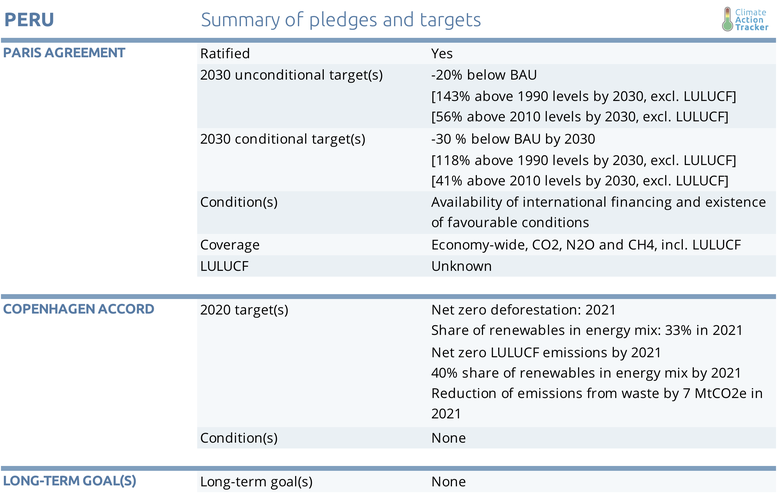Pledges And Targets
Summary Table

Paris Agreement targets
Peru ratified the Paris Agreement on 25 July 2016. In its NDC, the government of Peru proposes two targets: an unconditional reduction by 20% below a BAU scenario in 2030 and a conditional (on international finance) reduction of 30% below BAU scenario in the same year, both including LULUCF (Government of Peru, 2015c). In its NDC, total emissions under the BAU scenario are projected to reach 298.3 MtCO2e in 2030, with LULUCF emissions contributing to 53% of overall national emissions. We estimate that this level of emissions is equivalent to 145 MtCO2e excl. LULUCF.
The 2030 emissions level under the unconditional target is 131 MtCO2e. We estimate this translates to 143% above 1990 levels (56% above 2010 levels) and for the conditional target (118 MtCO2e in 2030) this translates to 118% above 1990 levels (41% above 2010 levels), with both estimates excluding LULUCF. For the unconditional target, the government projects that 76% of the total mitigation will be achieved in the forestry sector. The remaining 23% of mitigation will be achieved in the energy, transport, agriculture, industrial processes and waste sectors. For the conditional target, the government projects that 69% of emission reductions will be obtained in the forestry sector.
LULUCF emissions under business-as-usual are expected to almost double between 2012 and 2030 —the opposite of what is needed to achieve the Paris Agreement goal and Peru’s NDC. Even when successfully implementing the mitigation actions listed in the NDC for the forestry and land use sector, remaining emissions would still not be on track to reduce LULUCF emissions at least to 95% below 2010 levels by 2030 as required globally for a 1.5°C-consistent pathway.
Once the regulation of the new framework law on climate change is approved (expected by the end of this year), Peru’s Paris Agreement pledge will become legally binding (Ministerio del Ambiente del Perú, 2018).
According to our assessment, Peru is on track to overachieve its unconditional NDC target with its current policies. If one were to recalculate Peru’s unconditional NDC based on current policies, the emissions level would be reduced from 131 MtCO2e/yr excl. LULUCF to 125 MtCO2e/yr excl. LULUCF. If we were to translate this emissions level to the language of Peru’s NDC, this would mean be a reduction of 22% below BAU, incl. LULUCF (instead of the current target of 20% below BAU). Therefore, in updating its NDC, Peru will need to go beyond this level in order to be a true progression in scaling up climate action.
2020 pledges
Peru submitted the three pledges in the shape of NAMAs (Nationally Appropriate Mitigation Actions)1 under the Copenhagen accord in June 2010 (Government of Peru, 2010) which were later refined in Peru’s communication to the UNFCCC in November 2011 in the following way (GFLAC, 2015):
- To reduce net LULUCF emissions to zero by 2021,
- To increase the share of renewables in the energy mix to at least 40% by 2021, and
- To reduce emissions in the waste sector by 7 MtCO2e in 2021 (compared to the year 2000).
It was not possible to quantify the impact of these pledges, as baselines were not available. Nonetheless, the LULUCF pledge could have a substantial impact, as the LULUCF sector currently accounts for just over half of Peru’s total GHG emissions. However, this pledge was not reflected in NDC or the measures being considered under it. Recent deforestation trends, as well as the current share of renewables in the energy mix, are at odds with the achievement of these targets by 2021, unless action is scaled up substantially in 2020.
1| Nationally Appropriate Mitigation Actions (NAMAs) are voluntary measures undertaken by developing countries to contribute to greenhouse gas emission mitigation. The concept was introduced 2007 at the 13th session of the Conference of the Parties (COP) in Bali, Indonesia.
Further analysis
Latest publications
Stay informed
Subscribe to our newsletter




